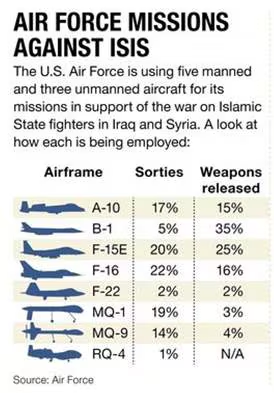WASHINGTON — After more than a year of airstrikes, the US military and coalition partners are beginning to see progress in the fight against the Islamic State group, Pentagon officials say.
But these gains could not have happened without the airmen of the 37th Bomb Squadron and their fleet of B-1B Lancers, who recently spent six months in the Middle East supporting coalition forces.
From last July to January, Lt. Col. Joe, who requested anonymity for his security and that of his family, commanded the squadron while it was deployed to Al Udeid Air Base in Qatar. Joe and his 350 B-1 pilots, weapons officers and maintainers operated 24-hour-a-day surveillance over Iraq and Syria, providing support to the coalition forces on the ground and the air component commanders in the region.
During that time, Joe and his squadron helped coalition forces make significant gains against the Islamic State group, also known as ISIS, liberating the city of Ramadi and the town of Sinjar, both in Iraq, in late 2015. During their missions, Joe and his airmen saw enemy guard areas, weapons caches and command and control hubs abandoned, and ISIS commanders' tactics thwarted.
"I really feel as though they did make a difference," Joe said in a recent interview. "I saw a regaining of the territory and recapturing of the cities and the regaining security of those cities, so I feel as though they felt really accomplished and that they were providing support to those folks."

A look at how the Air Force is employing its aircraft in the fight against ISIS
Photo Credit: US Air FOrce
During the six months Joe and his squadron were there, the B-1s flew a total of 490 sorties, employing approximately 5,000 munitions against enemy forces. The deployment had an extremely high operational tempo, as airmen set records for the most munitions employed by one B-1 squadron during a six-month rotation in the past 10 years. The squadron fulfilled 114 percent of its taskings throughout the deployment, flying just 5 percent of US Air Force aircraft sorties during that time but employing 35 percent of the munitions.
The squadron focused on targeting ISIS revenue, for instance oil refineries and cash banks, as well as training camps and checkpoints, Joe said. The B-1s also flew close-air support, or CAS, missions, protecting ground forces under fire in ISIS stronghold areas.
Depending on the terrain and battlefield environment, the Air Force uses different aircraft to protect soldiers on the ground from enemy fire, according Gen. David Goldfein, nominated by the White House to be the next Air Force chief of staff, who currently serves as the vice chief. In parts of the region where terrain is relatively flat, commanders want the A-10 attack plane. But in mountainous regions, commanders want the high-endurance, unmanned MQ-9 Reapers for CAS, Goldfein said recently.
The B-1 is particularly well-suited for these close-air support missions in the northern regions of Iraq and Afghanistan because of the number and variety of weapons the plane can carry, including 2,000-pound guided Joint Direct Attack Munitions, or JDAMS, and Joint Air-to-Surface Standoff Missiles, or JASSM. The planes can also fly over the fight for four to six hours between refuelings, providing "continuous, steady support for the ground forces that moved forward," Joe said.
One hundred percent of the weapons the B-1s dropped were precision-guided, Joe stressed, in keeping with the US military's emphasis on minimizing collateral damage.
"We were deliberate, we were precise, and there were rules to make sure we minimize that to the maximum extent," Joe said. "It was, when we were there, definitely a top priority."
Although the B-1s were built, designed and produced in the 1980s by Rockwell — now part of Boeing — the aircraft are constantly being upgraded and enhanced, Joe noted. Each of Joe's B-1s had the most advanced targeting pod and newest weapons in the region, as well as a communications suite that matched the capability of any in the Air Force's inventory, he said.
At any given time one aircraft would be offline for maintenance, but that is not uncommon for a deployed squadron, Joe said. The team sometimes had challenges getting spare parts to the forward operating location to make crucial repairs, but overall did not experience major maintenance problems, he said.
The B-1s left the region in January for the first time since 2001 to undergo the biggest fleetwide upgrade in the aircraft's long history, called Block 16, Joe said. During the maintenance period, the B-1s will get a full glass cockpit communications suite. Each of the planes will travel from its home at Ellsworth Air Force Base, South Dakota, to Tinker Air Force Base, Oklahoma, for the Block 16 upgrade, or Integrated Battle Station modification.
Joe is not sure when the B-1s will return to the region. But in the meantime, the planes are being replaced with the Cold War-era B-52s, which deployed to the Al Udeid Air Base earlier this month.
"It can appear to be a slow, difficult fight because it is, but there has also been some good movements through that, and I think that's a huge message," Joe said. "A big part of that was definitely the B-1s and our unit there. ... It just shows what kind of things air power can do."
The territory coalition forces regained during that time clearly demonstrated the clout of air power, Joe said.
Email: lseligman@defensenews.com
Twitter: @laraseligman







